Maverick Life
Space food: What do astronauts eat up there anyway?
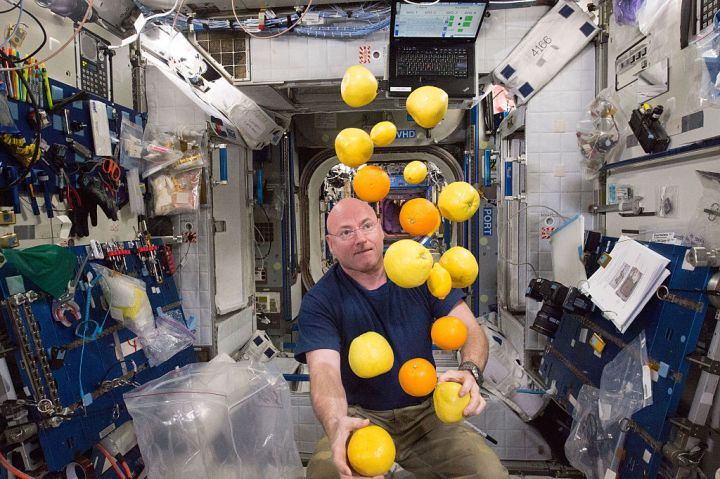
Is space food very different from the food we eat back on Earth? Apparently not, bar a few very tasty victuals – and the scents that usually go with a meal.
Back in 1957, the Soviet Union launched Sputnik 1, the first unmanned man-made satellite, into space. They followed it up four years later by sending Lieutenant Yuri Gagarin aboard the Vostok 1, making history as the first nation to send a human into space, and to orbit Earth.
On 30 May 2020, with the joint Nasa/SpaceX launch of astronauts into space, SpaceX founder Elon Musk’s dream of frequent space tourism became a little bit closer to reality, at least for the obscenely wealthy.
In February 2020, space tourism company Space Adventures announced that it had come to an agreement with SpaceX to offer tourist trips for private citizens aboard the Crew Dragon. Back in the noughties, between 2001 and 2009, Space Adventures organised eight tourism trips to the International Space Station (ISS) for seven of their clients, at a reported $20-million (R347-million) per person.
While that puts a space vacation far out of reach for all but the top 0.1%, us lowly folks can live in hope that the price will drop so low one day that phrases like “we’re thinking of wintering at the International Space Station this year” will become commonplace.
However, and most importantly, considering the havoc that microgravity plays with the human body, and the fact that there is limited refrigeration in space – the ISS got its first fridge in 2008, but more about that later – what will we eat? In fact, what have they been eating, up there, since humans started exploring space?
Firstly, let’s deal with the weightless elephant in the room, the zero-gravity myth. About 90% of the Earth’s gravity is felt at an altitude of 320km to 400km, which is the altitude at which the ISS orbits the planet. Mars has the equivalent of 38% of the Earth’s gravitational pull, and the moon 16.6%. In fact, the ISS is constantly falling towards Earth due to gravity, and in order to counter the Earth’s gravitational pull, it has to be constantly moving at a speed of at least 28,000km per hour, the speed which matches the way the Earth’s surface curves, so that it can remain in orbit.
Another way to think of it is, like when you throw a pebble straight ahead, for the first few milliseconds after it leaves your hand, at the highest speed, it travels horizontally, but as the pebble slows down, it can’t counter the gravitational pull, so it drops towards the ground.
The space station and other spacecraft are literally falling around the planet but never hit the ground, because, unlike our low-tech pebble, they can maintain speed. Thanks to gravity, the space station as well as everything in it, including the humans, are all perpetually falling toward the Earth’s pull at relatively the same speed, hence the floating experience known as zero-gravity, but perhaps more accurately defined as microgravity.
According to Nasa’s Human Research Program, without the same gravitational effect that the human body would experience on Earth, the bones lose minerals and bone density drops at a rate of 1% a month. Typically, an elderly human on Earth loses bone density at 1% to 1.5% a year. The fluids in the body also move upwards, potentially putting pressure on the eyes and causing vision problems. Then there’s the potential to develop kidney stones due to dehydration and the excretion of calcium from your bones. If there was ever a reason to be vigilant about exercise and nutrition, space travel will be it for those lucky and rich enough to experience life at such high altitudes.
Resources are limited in space, so space travellers have to be mindful to stick to the calories they need. However, unlike half a century ago, when astronauts had to sustain themselves with paste-like foods out of tubes, these days, as below, so above. They eat a diet familiar to us Earthbounds: three meals a day plus snacks, in line with their caloric needs.
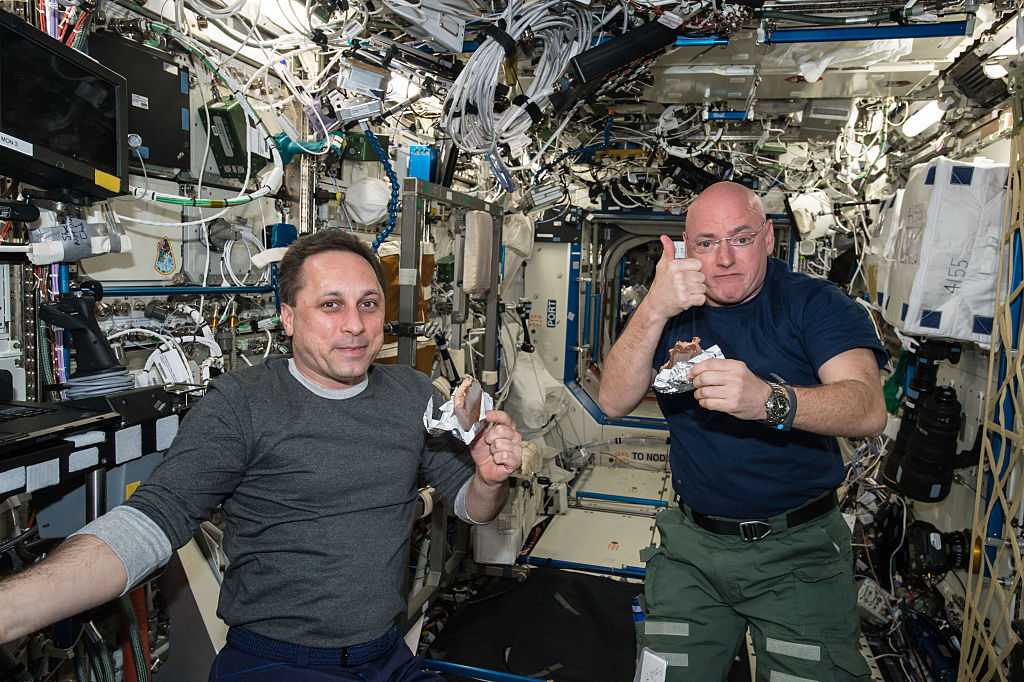
IN SPACE – APRIL 20: In this handout photo provided by NASA, NASA astronaut Scott Kelly gives a thumbs up on the quality of his snack while taking a break from his work schedule aboard the International Space Station on April 20, 2015 in space. He and Russian cosmonaut Mikhail Kornienko (ROSCOSMOS) are eating specially prepared space food. (Photo by NASA via Getty Images)
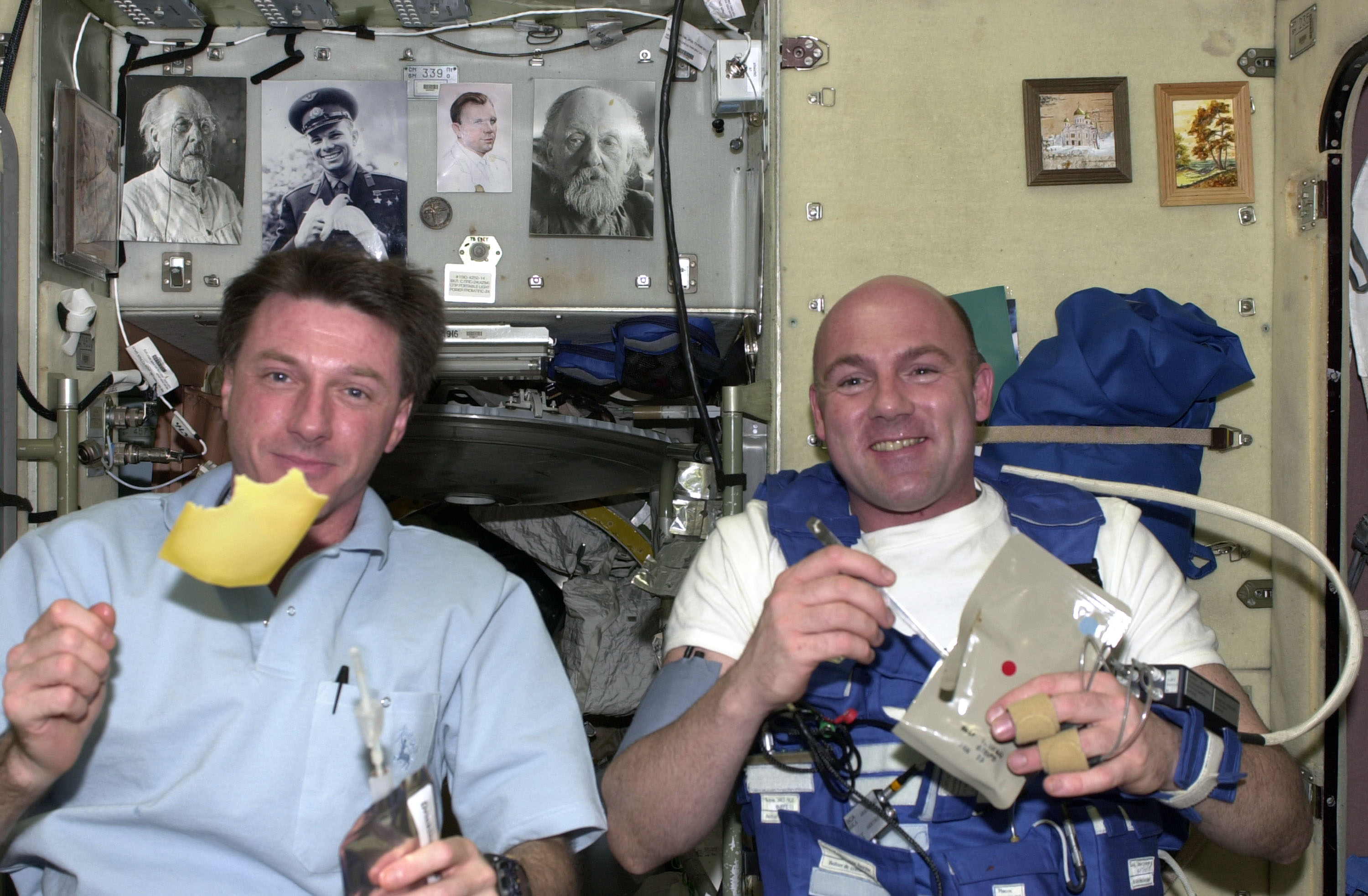
IN SPACE: Seen in this undated ESA handout out photo European Space Agency (ESA) astronaut Andre Kuipers (R) and his NASA colleague Michael Foale eat Dutch cheese for breakfast on board the International Space Station. (Photo by ESA/via Getty Images)
According to Nasa: “An astronaut can choose from many types of foods such as fruits, nuts, peanut butter, chicken, beef, seafood, candy, brownies, etc. Available drinks include coffee, tea, orange juice, fruit punches and lemonade. As on Earth, space food comes in disposable packages.” Condiments too: they get tomato sauce, mayonnaise and mustard. They also get salt and pepper, but to stop this floating away, it has to be suspended in liquid.
Unfortunately for true-blue junk food junkies, there are no sodas, no ice cream, no pizza: “Carbonated drinks currently don’t make the trip because the carbonation and the soda will separate in microgravity. Some experiments have been done with special microgravity dispensers for soda, but it has not been perfected yet. Ice cream or anything else frozen can’t go up, because we don’t have freezers, and try as we might, we just have not been able to come up with a good shelf-stable pizza. Beyond that, though, astronauts can find just about anything you’d order on a typical menu. The presentation might be different – the chicken à la king might be dehydrated – but the names are all the same,” says Vickie Kloeris, the sub-system manager for Shuttle and International Space Station food.
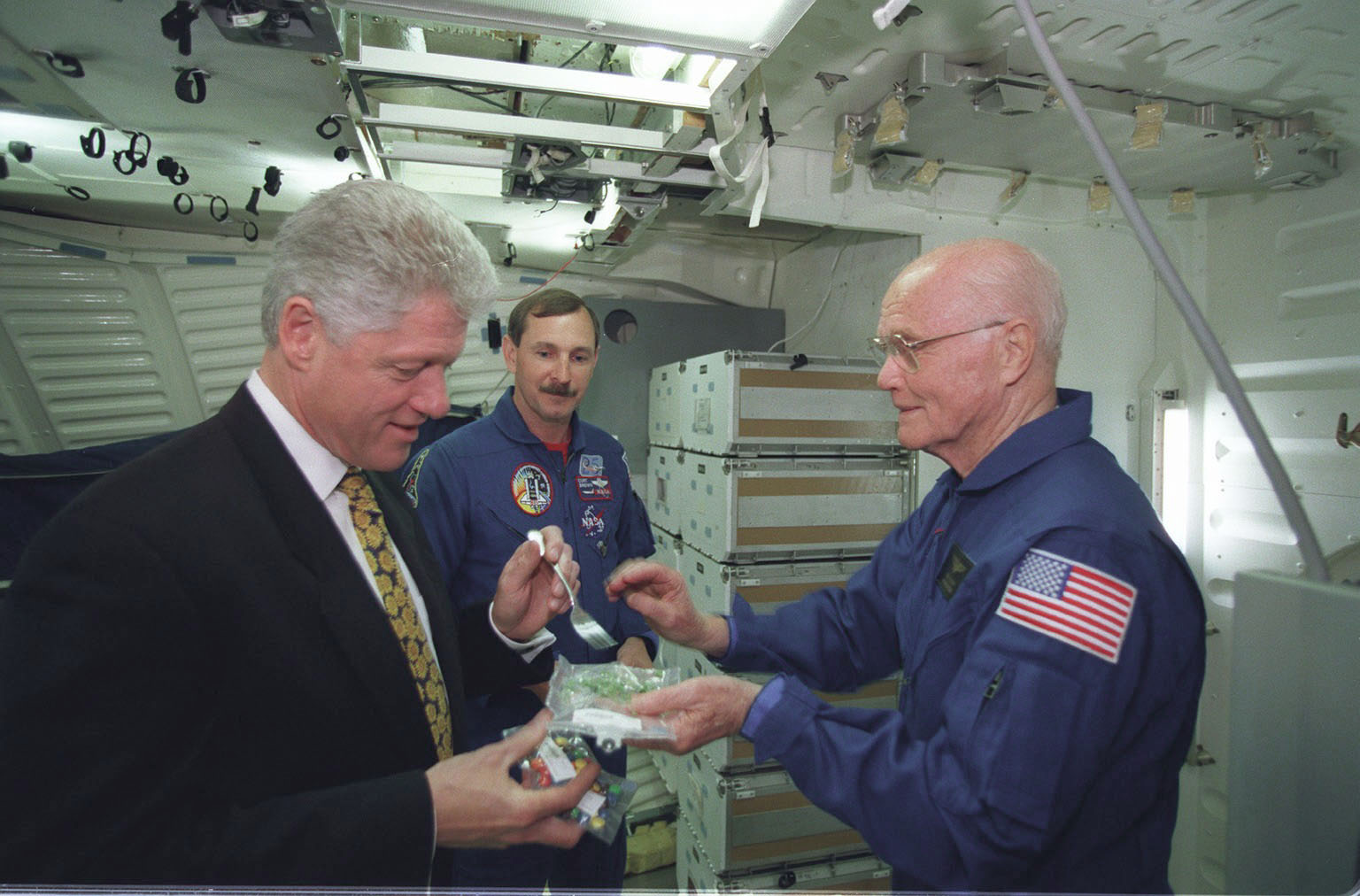
HOUSTON, TX – President Bill Clinton samples some space food offered him by Senator John Glenn (R) during a visit to the Johnson Space Center April 14, 1998 in Houston, TX. Glenn is currently undergoing astronaut training for a flight scheduled later this year aboard the Space Shuttle Discovery. Looking on is astronaut Curtis L. Brown Jr., STS-95 mission commander.
Which brings us to the refrigeration problem. Considering the limited resources, there isn’t much space for refrigeration on the ISS. Much of the energy and space required for refrigeration is used for science experiments and samples. In fact, they only got a fridge for food in 2008. So the food is freeze-dried on Earth before being shot out into space, to make it last longer as well as to reduce weight. So, astronauts need to rehydrate it to get it ready to eat. They can make hot meals by adding hot water, as well as using a convection oven; and they add cold water to powdered drinks for beverages. Some fruits can be eaten dry, much like the dehydrated fruits often found in breakfast cereals.
There’s one little catch when it comes to taste. While the food maintains its flavour, the aroma doesn’t necessarily rise to the nose; because of the microgravity, it dissipates. Aroma plays a big part in our sense of taste, and without it, the experience of certain foods can be less than satisfying.
Another thing to keep in mind for would-be space vacationers, you won’t be getting much sun up there, so if you manage to wrangle a long stay, say a few months, take your vitamin D supplements among the many other supplements that will be recommended for you.
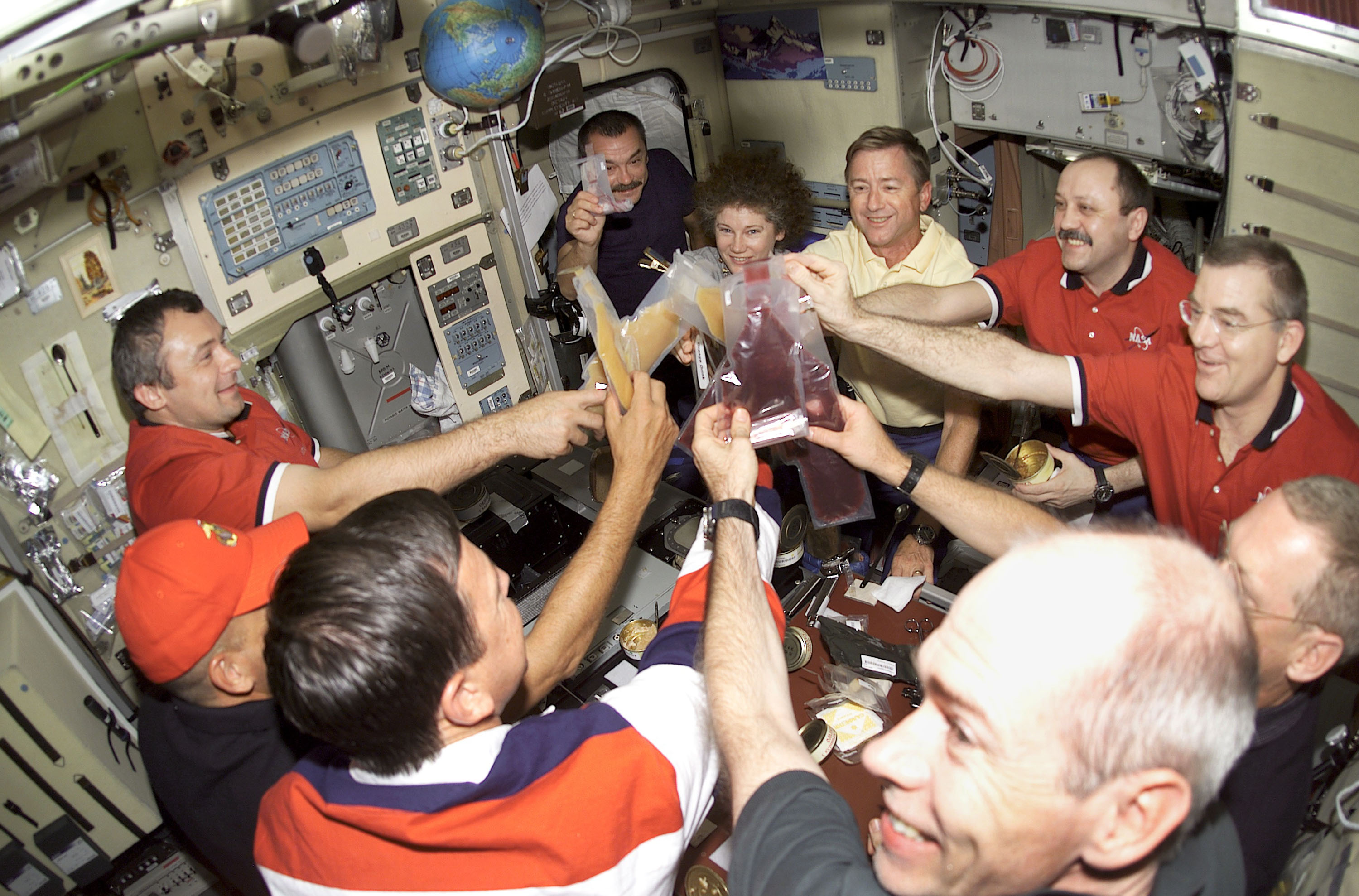
Beverages are held high in a toast onboard the Zvezda Service Module of the International Space Center as the astronauts and cosmonauts of the STS-105 and Expedition Two and Expedition Three gather August 15, 2001 for one of their first meals. Mission STS-105 activities include a crew change at the International Space Center, space walks and scientific experiments. (Photo Courtesy of NASA via Getty Images)
Then there’s the water situation. Up until the 2008 makeover that also saw the ISS get a fridge, primarily for fruit and beverages, they were dependent on water sent from Earth, but the 2008 refurb came with, “A new regenerative environmental control and life support system [that] will give the station the ability to recycle urine and the condensation that the crew breathes into the air into pure water that can be used for drinking or to cool the station’s systems.” Yes, they hydrate themselves with a cocktail of recycled breath and urine. Still into it. DM/ML


















 Become an Insider
Become an Insider